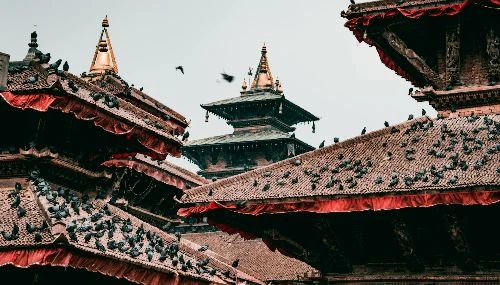The Langtang Trek is of moderate difficulty, making it suitable for trekkers with average physical fitness.
Located in the north-central part of Nepal, the Langtang region features rugged terrain and narrow valley paths. The terrain ranges from dense forests of rhododendrons, pine, and oak trees in the lower altitudes to alpine meadows and glacial moraines as you ascend higher.
While some trekking itineraries venture into the lower regions, you will reach altitudes as high as 4,984m at Tsergo Ri in some.
Thanks to its diverse terrain, rich cultural heritages, and popular destinations, the Langtang region allows for diverse trekking plans such as the Langtang Valley Trek, Langtang Gosaikunda Trek, Tamang Heritage Trek, and Langtang Helambu Trek.
Each trip has its challenges, and this blog will delve in detail into the intricacies that contribute to Langtang Trek's difficulty.
The challenge of the trek arises from various factors such as its location and terrain, elevation and altitude, distance, duration, trekking hours, weather conditions, seasonal variations, as well as accommodation and meals.

Location and Terrain
The Langtang region poses a formidable challenge due to its remote location and rugged terrain. Located in the mountains of north-central Nepal, within the Langtang National Park, the valley lies approximately 80 kilometers north of the Kathmandu Valley in the Rasuwa district of the Bagmati province.
One of the foremost challenges of this trek comes from its mountainous terrain. Although not as steep as some other trekking routes, the path is still steep in ascents and descents, rocky terrain, and narrow valley paths.
You’ll trek through dense forests, terraced hill slopes, and high pastures. In addition, Langtang trails lead to the moraine of glaciers and peaks adding more difficulty.
Moreover, the remoteness of the Langtang Valley adds fuel to the flames. The nearest motorable roadhead is Syabrubesi, a starting point for most of the treks in the Langtang region.
However, reaching Syabrubesi from Kathmandu isn’t easy. Despite being a mere 80 kilometers away, the drive typically takes 6 to 8 hours due to the road difficulties.
In case of emergencies, evacuation can be difficult and time-consuming, particularly in adverse weather conditions.

Elevation and Altitude
The Langtang Trek doesn't reach the extreme altitudes of some other Himalayan treks, such as Everest Three High Pass Trek and Annapurna Circuit Trek, however, elevation and altitude still significantly impact the difficulty and experience of the trip.
Langtang village is located at an altitude of 3540 meters, which makes it an ideal spot to stargaze in the Langtang region. It’s a significant ascent from the lower altitudes and can give you an idea of how your body might react to higher elevations.
Altitude-related issues are less common at this point compared to more extreme altitudes but precaution is better than cure so be aware of any signs of discomfort or illness.
As you trek towards Kyanjin Gompa and Tsergo Ri on the Langtang Valley Trek, for example, the altitude gradually increases, reaching its peak at 4985 meters. This elevation gain gives a heightened risk of acute altitude sickness also known as acute mountain sickness (AMS).

Distance, Duration, and Trekking Hours
The Langtang Trek spans approximately 70 to 90 kilometers (43 to 56 miles) long, a considerable distance to cover on foot.
This distance is full of physical challenges as trekking such a distance requires stamina, endurance, and proper physical fitness.
Likewise, the duration of the trek can vary depending on the itinerary chosen, ranging from 8 to 17 days. While the shortest trek is the Langtang Valley Trek lasting 8 days, the longest is the Langtang Gosaikunda Trek which lasts 17 days.
Enduring such a continuous trekking duration requires mental resilience and physical fitness.
The longer the trek, the more prolonged exposure to potential challenges such as weather conditions, fatigue, and altitude effects.
The journey to the starting point of the trek, Syabrubesi, involves an 80-kilometer drive from Kathmandu. Once the trek begins, you'll be walking around 10 to 20 kilometers every day, which means you'll need to keep up your energy and effort all the time.
Each day of the trek typically involves sustained walking for around 6 hours. While this may not seem excessive, the terrain and altitude can make it feel harder than usual.
Weather Conditions and Seasonal Variations
The Langtang region experiences a wide range of weather conditions from hot to humid in the lower elevations to freezing temperatures at higher altitudes.
During the trekking season (March to May and September to December) weather conditions are stable.
During the monsoon season (June to August), there's heavy rainfall which can lead to landslides and slippery trails making trekking hazardous.
During the winter (December to February), temperatures in Langtang can drop significantly, especially at higher elevations. Snowfall is common in Gosaikunda when you’re on the Langtang Helambu Trek and trails may be covered in snow and ice making them slippery and difficult to walk.

Accommodation and Meals
As the Langtang region lies in a remote part, the facilities such as accommodation, food, and medical services are limited. The accommodation options vary depending on the specific section of the trek.
Along the Tamang Heritage Trail, where you'll see more traditional Nepali-Tamang life, lodges are modest. Some are older, while others are newer but still built in a traditional style because of an earthquake.
In the Langtang Valley, the lodges are better and more comfortable, but they're still not fancy. They have big stoves for warmth, but the bedrooms don't have heaters.
In terms of facilities, some lodges have showers and toilets, but they can be pretty basic. Some might even have squat toilets instead of regular ones.
But don't worry, you'll have options for meals. They serve local Nepali food and some Western dishes, so you'll find something you like.
While the accommodation and meals might not be like what you're used to at home, they're part of the adventure of trekking in Langtang.

Trip-Wise Overview of Trek Difficulty in the Langtang Region
Major theme/focus | Explore the Langtang Valley’s ancient monasteries, panoramic mountain views, and diverse flora and fauna while immersing in Nepali-Tibetan Buddhist culture. | Exploration of the sacred Gosaikunda Lake. | Experience the vibrant culture and lifestyle of Nepal’s Tamang people. | Cultural immersion in villages like Langtang and Helambhu (home of Hyolmo people.) |
|---|---|---|---|---|
Unique identifier for each trek (in terms of itinerary) | Stroll around Langtang village, home to the Tamang people and Tibetan Buddhist Sherpas. | Absorb the beauty of the glacial lake Gosaikunda while enjoying the mountain views of Annapurna, Hiunchuli, Manaslu, Ganesh, and Langtang along the way. | Trek from Syabru Besi to Gatlang via Goljung and enjoy the cultural show at Goljung Valley. | Enter the Helambhu region via Lauribina Pass where you’ll meet the Hyolmo people, get to taste local apples, and visit artistic Buddhist monasteries and pilgrimage sites. |
Highest location reached | Tsergo Ri Altitude: 4984 m | Gosaikunda Altitude: 4380 m | Tatopani Altitude: 2607 m | Gosaikunda Altitude: 4380 m |
Highest sleeping altitude | Kyanjin Gompa (3830 m) | Gosaikunda (4380 m) | Tatopani (2607 m) | Gosaikunda (4380 m) |
Total Trip Duration | 8 Days | 17 Days | 10 Days | 13 Days |
Actual Trek Duration | 6 Days | 13 Days | 6 Days | 12 Days |
Average trekking hours on trek days | 6 to 7 hours | 6 to 7 hours | 6 to 7 hours | 6 to 7 hours |


.webp)

